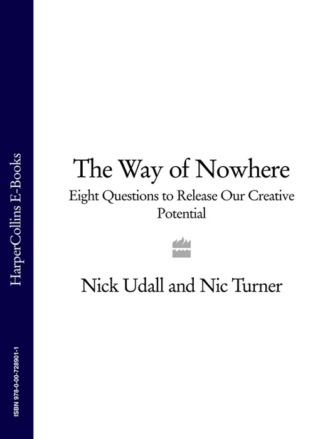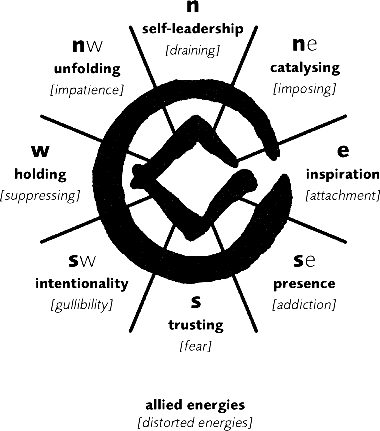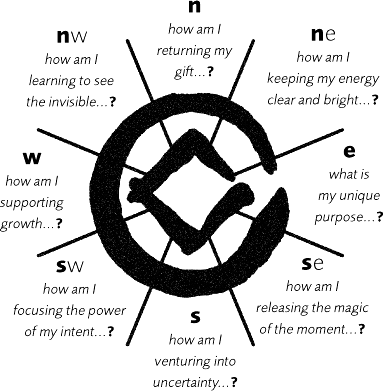
Полная версия
The Way of Nowhere: Eight Questions to Release Our Creative Potential
We are also very different. Nick is almost a generation younger and works much more quickly than I do. I tend to champion the purity of the practices and the wisdom traditions they come from; he wants to play irreverently with whatever works.
These differences manifest as creative and emotional tensions in our relationship. People are sometimes surprised at how we bicker, argue and disagree. They find it uncomfortable, as sometimes do we! But we always stay with it. There is always an unquestioning underlying trust and respect that enables us to eventually break through into new insights and innovations.
The book you now hold in your hands is one expression of this relationship. You can trace the breakthrough questions and the overall structure back to Zen influences – Nick's primary background. The medicine wheel, the allies and distortions come from Earth Wisdom, which has been a larger part of my own development and training.
This living practice has brought meaning and challenge into our lives. It heightens our awareness of those things that expand our creative potential while contracting those things that diminish it.
Please remember that if there are any bits in this book you really don't like, they probably came from the other Nick because he works more quickly!
co-creation
The Way of nowhere is based upon the philosophy of co-creation.
Co-creation is the creative interplay or interconnectedness of all things. It is also the name we give to the process of releasing the creative potential that exists within and between all things.
One of the core teachings at the heart of the Way of nowhere is what we call the Diamond of Consciousness. It was given to us by one of our most influential teachers at a critical point in the development of nowhere.6 He said it had come to him in a dream and that he had a strong intuitive sense that we should integrate it into our work.
The North of the diamond represents our everyday consciousness. Whilst constituting a relatively small part of who and what we are, this aspect of ourselves takes up a hugely disproportionate amount of our awareness.
The South represents our subconscious, our emotional Self, which is also a very small but extremely influential part of who we are, as it drives our needs and desires.
The West represents the largest percentage of who and what we are. It reminds us that we are forever and always from the Field,7 part of an interconnected whole.
the diamond of consciousness

And lastly, the East represents that very small and under-developed aspect of ourselves which we have called creative-consciousness. This is our ability to be present and at one with the Field, with our wholeness, and the interconnectedness of all things. Our teacher went on to outline how this capacity had diminished in modern society and how vital it was that we increased our ability to access it to face the challenges and opportunities ahead.
Our teacher also described how the developmental and personal growth work that many people are undertaking today, particularly in West, contributed greatly to cleaning the North and South axis of the diamond. He explained that the cleaning of this space was a prerequisite for tapping into the power and insights that flowed along the West–East axis of the diamond.
When our teacher passed this to us, we instantly recognized that the diamond gave us a new and useful way of looking at what we were doing and an insight into what we should focus on going forward. Thus a vital difference between the Way of nowhere and other developmental approaches is that while we both recognize and work with processes to expand our conscious and subconscious, we do so in the interest of awakening our creative-consciousness – our co-creative Self.
Creative-consciousness is our innate ability to gain inspirational insights from the whole. Such insights often have an ‘Of course, why didn't I think of that before?’ quality about them, yet they have the potential to bring innovation to the world. They also enable us to move towards being the inspiration and innovation we want to see and be.
This book introduces what we call the art and practice of inspiring-innovation (i-i). The art is how to apply the virtuous circle of inspiration and innovation to families, communities, organizations and any other form of social system. The practice is how to apply this virtuous circle to the only social system which we can control: ourselves. We refer to it as a ‘practice’ because we literally have to practise it, like yoga or running. We have to internalize it and embody it. The more we do so, the more profound its effects will be, just as a professional marathon runner develops more blood vessels than a sedentary person or a highly experienced meditator's brain structure differs subtly from that of a non-meditator.8
This book has been designed to trigger this virtuous circle of inspiration and innovation within us, thus significantly increasing our ability to access breakthrough insights. It then supports us in finding ways to turn those insights into innovative form, one continually fuelling the other in constant motion and exchange.
6 A gift from RainbowHawk, one of Ehama's grandparents and keepers.
7 For an excellent explanation of this vital concept, see Lynne McTaggart, The Field, HarperCollins, 2001.
8 Inspired by a lecture by Andrew Newberg, Fred Travis and Antoine Lutz entitled ‘Neural correlates of meditative experience’, presented at ‘Towards a Science of Consciousness’ conference in Tucson, Arizona, 8–12 April 2002.
wheels
Our challenge has been to co-create a living practice that is fit for purpose in today's world. From the ancient wisdom traditions we have extracted those personal disciplines and practices that alter the way in which we see ourselves and the world around us. From the modern disciplines we have taken an understanding of the social systems that we co-create and perpetuate and how we can learn to find our place within them. From the world of design we have learned how to turn energy into form, turning these personal practices and social disciplines into innovative processes and liberating experiences.
One of the most influential components of our practice has been the use of ‘medicine wheels’. Medicine (or wisdom) wheels are systemic designs based on an ancient taxonomy of the universe, and over the last 12 years we have experimented with this 35,000-year-old technology and applied it rigorously to unlocking the creative potential of individuals, teams and organizations – with great success.
While we have deep respect and appreciation of the traditional forms of the medicine wheels, which we employ in other aspects of the Way of nowhere, we have developed our own unique set of wheels by codifying our learning from thousands of interventions. Whilst our wheels are inspired by and consistent with the founding wheels, they vary in some important aspects.9
Wheels are the only tools that we have discovered that simultaneously map and unlock the invisible forces within the self, within a team and within the wider social systems of which we are a part, thereby creating a truly systemic approach to change, development and transformation.
Wheels are an ancient way of mapping life's different energy states. They use the eight points of a compass, each one representing a different energy intelligence. Just as these exist in the outer world, so they also exist within us, because we are a microcosm of the whole.
Each direction can either manifest within us in ways that release our creative potential and interconnectedness or diminish our creative potential and accentuate our separateness.
In this particular wisdom tradition, the liberating energy states are called ‘allies’ or ‘allied robes’ and the diminishing energies are called ‘distortions’ or ‘distorted robes’. They are called robes because they resemble the clothes we wear. These robes cloak us in energy states and patterns of behaviour which we may or may not be conscious of. They exert a powerful influence over us, moving us either towards or away from our co-creative capacity.
We can use these allied and distorted energy states to develop awareness and ultimately mastery of the ways in which we either help or hinder our creativity.
Thus, through awareness and skill, we can learn to accelerate the virtuous circle of inspiration and innovation.
In this book we introduce the art and practice wheels of inspiring-innovation. We use the art wheel as the basis for releasing our collective creative potential, in particular through the discipline of organizational transformation, and we use the practice wheel as the basis for releasing my personal and inter-personal creative potential. Together they map an inner and outer journey of transformation. They have been designed to help us to look at our consciousness rather than through it as we are normally conditioned to do.
Imagine for a moment that these wheels are maps of our inner world, maps of the energy states that lie behind our thoughts and behaviour. As we navigate through the uncertain waters of life, these wheels can help us understand where we are at any given time and give us keys to unlock our creative potential. We do this by deepening and strengthening our allied capabilities and controlling and minimizing our distorted patterns. We then begin to learn how one ally can magnify another and how one distortion can trigger another.
The wheel is therefore a truly systemic tool, as each direction, whilst being complete in itself, is also an integrated part of the whole. This is also reflected in the way any given direction relates to its opposite and neighbours.

i-i practice wheel with the allied and distorted energies
The design of the book mirrors the design of the wheel. Each chapter is based on a breakthrough question which is designed to release the energy of one of the eight directions. As we enquire into the breakthrough question, we begin to access and heighten the energy intelligence of that direction. Yet our creative capacity is unlikely to grow if we simply read the book in the usual way. Runners do not elongate their blood supply systems by reading books about running! So our invitation to you is to hold and meditate on each breakthrough question, a chapter at a time. Seek the insights that lie within each question, between each question and its ally and distortion, and between each word and each thought.
Then, as we move towards the centre of the book, we also move towards the centre of ourselves, until we stand in the middle of our circle and fully maximize who we are.
i-i practice wheel with the 8 breakthrough questions

9 Based on the Native American Earth Wisdom tradition of the Ehama Institute.
how to use the wheel
Before we dive into the breakthrough questions themselves, let us suggest how best to use the wheel.
This book has two interconnected halves, one looking at ways of releasing my creative potential and the other looking at ways of releasing our creative potential. Within each half of the book there are eight chapters, one for each direction of the wheel. In line with tradition, we start in the East and move clockwise around the wheel. At the end of each half of the book is a chapter looking at what it means to stand in the centre of our circle. And in the middle of the book is the final chapter leading us to the Way of nowhere.
Each of the main chapters is dedicated to a breakthrough question. The eight questions are:
e what is my unique purpose… ?
se how am I releasing the magic of the moment… ?
s how am I venturing into uncertainty… ?
sw how am I focusing the power of my intent… ?
w how am I supporting growth… ?
nw how am I learning to see the invisible… ?
n how am I returning my gift… ?
ne how am I keeping my energy clear and bright… ?
Each is followed by a two-verse haiku.10 These haiku are designed as poetic summaries of each direction. Each line forms the essence of a key aspect of the breakthrough question.
The first verse of the haiku looks at the breakthrough question through the lens of the allied energy. The first line of the second verse looks at the breakthrough question through the lens of the distorted energy, and the second and third lines of the second verse offer views from the opposite and neighbouring directions of the wheel respectively.
For example:

Insights lie in the juxtaposition of the question and the commentaries.
Each chapter also introduces:
a Way of unlocking our creative and collective potential
an anecdote from a person who has had direct knowledge and experience of the Ways of nowhere
one or two micro-skills – ways of thinking or relating that can help release creative potential
We have intentionally chosen not to name those people who have offered their anecdotes. Their contributions are meant to offer alternative voices and perspectives. They are all inspiring people with whom we have enjoyed mutually nourishing relationships.
The book has not been written to be read in one sitting. Instead we invite you to work through one half of the book, making your way, question by question, chapter by chapter, to the middle. Let each chapter, each breakthrough question, soak in before moving on.
Once you find yourself in the middle of the book, start again from the other end, for neither side is complete without the other. Our success in the world is of little value unless we are developing ourselves, while self-development for its own sake can be indulgent unless we use it to create together.
Reading both sides of the book will enable you to fully extract the insights that lie at the centre, where the two halves come together. The book can then become an ongoing resource for practising the Way of nowhere.
Lastly, in the same way that we see ourselves in nowhere as creative-catalysts, we invite you to use this book to catalyse creative breakthroughs in your own life and in the lives of the people around you. Simply suspend disbelief and open yourself to new possibilities. By wandering with wonder through our co-creative universe, you will find amazing things starting to happen, as if by magic … out of nowhere.
10 A haiku is a minimalist form of Japanese poetry designed to convey an experience. It has a syllabic structure of 5–7–5, which is based on the utterance of a single breath.
the 8 questions
You are about to enter the inspiring-innovation wheel.
May your journey bring new meaning and creativity into your life.
May you return the gift of your uniqueness for the benefit of all.
Конец ознакомительного фрагмента.
Текст предоставлен ООО «ЛитРес».
Прочитайте эту книгу целиком, купив полную легальную версию на ЛитРес.
Безопасно оплатить книгу можно банковской картой Visa, MasterCard, Maestro, со счета мобильного телефона, с платежного терминала, в салоне МТС или Связной, через PayPal, WebMoney, Яндекс.Деньги, QIWI Кошелек, бонусными картами или другим удобным Вам способом.



